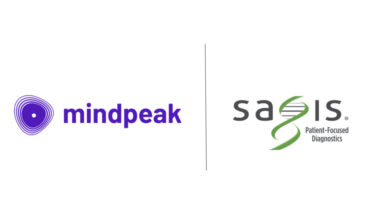Quizartinib Plus Chemotherapy Significantly Improved Overall Survival Compared to Chemotherapy in Patients with Newly Diagnosed FLT3-ITD Positive Acute Myeloid Leukemia

- Doubling of median overall survival seen in QuANTUM-First results presented at EHA Presidential Symposium
- Data support potential of quizartinib as targeted therapy for aggressive FLT3-ITD subtype of AML
TOKYO & BASKING RIDGE, N.J.–(BUSINESS WIRE)–Positive results from the global pivotal QuANTUM-First phase 3 trial of Daiichi Sankyo’s (TSE:5468) quizartinib combined with standard induction and consolidation chemotherapy and then continued as a single agent demonstrated a statistically significant and clinically meaningful improvement in overall survival (OS) in adult patients aged 18-75 with newly diagnosed FLT3-ITD positive acute myeloid leukemia (AML) compared to standard chemotherapy alone. The data were featured as part of the press program and presented during the Presidential Symposium (#S100) at the European Hematology Association (#EHA2022) Congress.
AML is one of the most common leukemias in adults with an estimated five-year survival rate of approximately 30.5%.1,2 Of all newly diagnosed cases of AML, 25% carry the FLT3-ITD gene mutation, which is associated with particularly unfavorable prognosis including increased risk of relapse and shorter overall survival.3
Quizartinib combined with standard induction and consolidation chemotherapy and then continued as a single agent demonstrated a 22.4% reduction in the risk of death compared to standard chemotherapy alone (HR = 0.776 [95% CI: 0.615-0.979; 2-sided p=.0324]) in patients with newly diagnosed FLT3-ITD positive AML. After a median follow-up of 39.2 months, median OS was more than double at 31.9 months for patients receiving quizartinib (95% CI: 21.0-NE) compared to 15.1 months for patients receiving chemotherapy (95% CI: 13.2-26.2).
The safety of quizartinib combined with intensive chemotherapy and as continuation monotherapy in QuANTUM-First was generally manageable, with no new safety signals observed. Rates of grade 3 or higher treatment emergent adverse events (TEAEs) were similar for both study groups and the most common grade 3 or higher TEAEs occurring in ≥ 10% of patients were febrile neutropenia (43.4% quizartinib; 41.0% placebo), neutropenia (18% quizartinib; 8.6% placebo), hypokalemia (18.9% quizartinib; 16.4% placebo) and pneumonia (11.7% quizartinib; 12.7% placebo). Rates of TEAEs associated with fatal outcomes were 11.3% for quizartinib versus 9.7% for chemotherapy alone and were mainly due to infections.
QTcF > 500 ms occurred in 2.3% of patients receiving quizartinib and 0.8% of patients discontinued quizartinib due to QT prolongation. Ventricular arrhythmia events with quizartinib were uncommon. Two (0.8%) patients experienced cardiac arrest with recorded ventricular fibrillation on ECG (one with fatal outcome) both in the setting of severe hypokalemia.
“The QuANTUM-First results show that adding quizartinib to standard chemotherapy significantly improved overall survival in patients with newly diagnosed FLT3-ITD positive acute myeloid leukemia,” said Harry P. Erba, MD, PhD, Instructor, Department of Medicine, Division of Hematologic Malignancies and Cellular Therapy, Duke Cancer Institute. “There is great interest in the increased use of targeted therapies to improve outcomes for patients with AML, particularly those with the FLT3-ITD subtype, which is one of the most common, aggressive and difficult-to-treat.”
“We are proud that another one of our medicines has demonstrated a significant survival advantage, as our goal is to leverage innovative science to change the way cancer is treated,” said Ken Takeshita, MD, Global Head, R&D, Daiichi Sankyo. “Adding targeted treatment with quizartinib, a potent and selective FLT3 inhibitor, to standard chemotherapy resulted in a doubling of median overall survival in patients with newly diagnosed FLT3-ITD positive acute myeloid leukemia compared to standard chemotherapy alone. Based on these positive QuANTUM-First results, we have initiated global regulatory filings in order to bring quizartinib to patients as quickly as possible.”
The OS improvement with quizartinib was also supported by a sensitivity analysis censoring for the effect of allogenic hematopoietic stem cell transplant (HSCT) (HR = 0.752; [95% CI: 0.562-1.008]).
Additional secondary and exploratory analyses provide further understanding and some supporting evidence for improved OS in patients receiving quizartinib combined with chemotherapy in the trial.
The primary event-free survival (EFS) analysis (with induction treatment failure (ITF) defined as not achieving complete remission (CR) by day 42 of the last induction cycle), did not show a statistically significant difference between the two study arms; two pre-specified sensitivity analyses on EFS (the first one defining ITF as not achieving CR by the end of induction; the second one defining ITF as having not achieved composite complete remission (CRc) by the end of induction) showed HR = 0.818 [95% CI: 0.669, 0.999] and HR = 0.729 [95% CI: 0.592-0.897], respectively.
The CRc rate was numerically higher for patients receiving quizartinib compared to chemotherapy alone (71.6% versus 64.9%), and rates of CR were similar for the two study arms (54.9% and 55.4%). The median duration of CR was 38.6 months for quizartinib (95% CI: 21.9-NE) and 12.4 months for chemotherapy (95% CI: 8.8-22.7).
The median relapse-free survival (RFS) for patients who achieved CR was 39.3 months for quizartinib and 13.6 months for placebo, representing a 38.7% relative risk reduction of relapse or death (HR = 0.613 [95% CI: 0.444-0.845]).
Summary of QuANTUM-First Results for OS
| Efficacy Measure* | Quizartinib + | Placebo + | HR |
| OS Primary Analysis Median OS (95% CI) | 31.9 months (21.0 – NE) | 15.1 months (13.2 – 26.2) |
HR = 0.776 (0.615 – 0.979) 2-sided p = 0.0324 |
*A hierarchical testing procedure was used to test the primary endpoint OS, followed by EFS, CR and CRc. Formal statistical testing was stopped after EFS as its result was not statistically significant.
Data cut-off: August 13, 2021
Abbreviations: HR = Hazard ratio; NE = not estimable; OS = overall survival
About QuANTUM-First
QuANTUM-First is a randomized, double-blind, placebo-controlled global phase 3 study evaluating quizartinib in combination with standard induction and consolidation chemotherapy and then as continued single agent therapy in adult patients (aged 18-75) with newly diagnosed FLT3-ITD positive AML. Patients were randomized 1:1 into two treatment groups to receive quizartinib or placebo combined with anthracycline- and cytarabine-based regimens. Eligible patients, including those who underwent allogeneic HSCT, continued with single agent quizartinib or placebo for up to 36 cycles.
The primary study endpoint was OS. Secondary endpoints include EFS, post-induction rates of CR and CRc, and the percentage of patients who achieve CR or CRc with FLT3-ITD minimal residual disease negativity. Safety and pharmacokinetics, along with exploratory efficacy and biomarker endpoints, also were evaluated. QuANTUM-First enrolled 539 patients at 193 study sites across Asia, Europe, North America, Oceania and South America. For more information, visit ClinicalTrials.gov.
About Acute Myeloid Leukemia (AML)
More than 474,500 new cases of leukemia were reported globally in 2020 with more than 311,500 deaths.4 AML is one of the most common types of leukemia in adults, representing about one-third of all cases, and the average age of diagnosis is 68 years old.1 The five-year survival rate for AML is 30.5%, the lowest by far among the major leukemia subtypes, and is 9.4% for patients aged 65 and older.5,6,7 The conventional treatment for newly diagnosed AML is intensive induction and consolidation chemotherapy with HSCT for eligible patients.8 The introduction of new targeted therapies in recent years has added to the standard of care and improved outcomes for some patients with molecularly defined AML subtypes.9
About FLT3-ITD
FLT3 (FMS-like tyrosine kinase 3) is a tyrosine kinase receptor protein normally expressed by hematopoietic stem cells that plays an important role in cell development, promoting cell survival, growth and differentiation through various signaling pathways.3 Mutations of the FLT3 gene, which occur in approximately 30% of AML patients, can drive oncogenic signaling.3 FLT3-ITD (internal tandem duplication) is the most common type of FLT3 mutation in AML, occurring in about 25% of all newly diagnosed patients, and is associated with increased risk of relapse and shorter overall survival.3
About Quizartinib
Quizartinib is an oral, highly potent and selective type II FLT3 inhibitor currently in clinical development for the treatment of FLT3-ITD positive AML.3 In addition to QuANTUM-First, the quizartinib development program includes a phase 1/2 trial in pediatric and young adult patients with relapsed/refractory FLT3-ITD AML in Europe and North America. Several phase 1/2 combination studies with quizartinib are also underway at The University of Texas MD Anderson Cancer Center as part of a strategic research collaboration focused on accelerating development of Daiichi Sankyo pipeline therapies for AML.
Quizartinib has received Fast Track Designation from the U.S. Food and Drug Administration for the treatment of adult patients with newly diagnosed AML that is FLT3-ITD positive, in combination with standard cytarabine and anthracycline induction and cytarabine consolidation. Orphan Drug Designation has been granted to quizartinib for the treatment of AML in Europe, Japan and the U.S.
Quizartinib is currently approved for use in Japan under the brand name VANFLYTA® for the treatment of adult patients with relapsed/refractory FLT3-ITD AML, as detected by an approved test. Quizartinib is an investigational medicine in all countries outside of Japan.
About Daiichi Sankyo
Daiichi Sankyo is dedicated to creating new modalities and innovative medicines by leveraging our world-class science and technology for our purpose “to contribute to the enrichment of quality of life around the world.” In addition to our current portfolio of medicines for cancer and cardiovascular disease, Daiichi Sankyo is primarily focused on developing novel therapies for people with cancer as well as other diseases with high unmet medical needs. With more than 100 years of scientific expertise and a presence in more than 20 countries, Daiichi Sankyo and its 16,000 employees around the world draw upon a rich legacy of innovation to realize our 2030 Vision to become an “Innovative Global Healthcare Company Contributing to the Sustainable Development of Society.” For more information, please visit www.daiichisankyo.com.
References
1 American Cancer Society. Key Statistics for Acute Myeloid Leukemia. Updated January 2020.
2 National Cancer Institute SEER Program. Cancer Stat Facts: Acute Myeloid Leukemia
3 Daver N et al. Leukemia. (2019) 33:299–312.
4 Global Cancer Observatory. Population Fact Sheet: World. Updated November 2020.
5 National Cancer Institute SEER Program. Cancer Stat Facts: Acute Myeloid Leukemia: 5-Year Survival Rates
6 Leukemia and Lymphoma Society. Facts and Statistics. Leukemia: Survival
7 National Cancer Institute SEER Explorer. Acute Myeloid Leukemia: 5-Year Survival Rates by Age
8 Daver et al. Blood Cancer J (2020) 10(10):107
9 Short et al. Cancer Discov. (2020);10:506–25.
Contacts
Global/US:
Jennifer Brennan
Daiichi Sankyo, Inc.
[email protected]
+1 908 992 6631 (office)
+1 908 900 3183 (mobile)
Japan:
Masashi Kawase
Daiichi Sankyo Co., Ltd.
[email protected]
+81 3 6225 1126 (office)
Investor Relations Contact:
[email protected]



